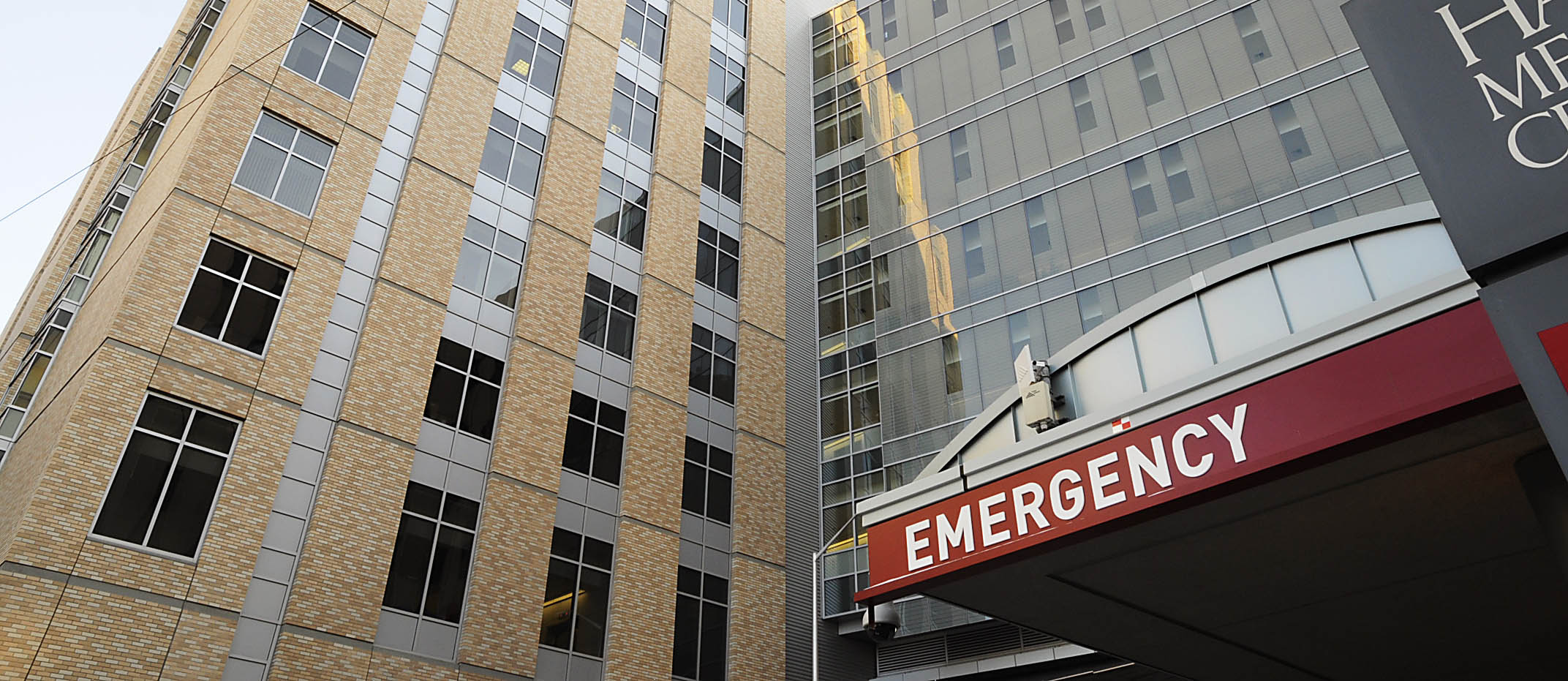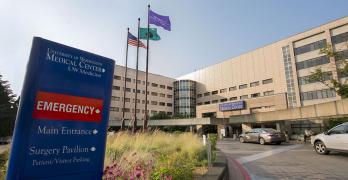Vascular Care
Leading treatment for the health of your arteries and veins

Life-saving, life-changing vascular care.
Best Care Out There
Our vascular surgeons are leading experts in common, complex and rare vascular diseases and well-versed in state-of-the-art diagnostic and therapeutic techniques.
We're On Your Team
No stone is left unturned with your care. The vascular team works closely with you to determine the best treatment for your individual needs.
Longer, Healthier Lives
Our vascular experts participate in clinical trials and treat more patients with renal artery aneurysms (RAA) a year than any other healthcare facility in the Northwest.

Meet the provider: Elina Quiroga
Elina Quiroga, M.D., MPH, is a board-certified surgeon at the Vascular and Endovascular Surgery Clinic at Harborview Medical Center. She is also a UW associate professor of surgery and the associate director for vascular surgery residency and fellowship training programs. View full bio.
Some of our common services:
This is the removal of part or all of a body part that's enclosed by skin, such as an arm, leg, or finger. Amputation is sometimes required to prevent the spread of gangrene as a complication of diabetes, atherosclerosis, or another condition that limits circulation.
An aneurysm is a bulge or “ballooning” weak area in the wall of a blood vessel. It may occur in any blood vessel, but most often develops in an artery. If an aneurysm grows large, it can burst, causing dangerous bleeding or even death. An aneurysm can be characterized by its location, shape and cause.
These occur in the abdominal aorta, the main artery that runs from the heart through the abdomen. Our vascular surgeons are leaders in fenestrated endovascular aortic repair (FEVAR), which uses a specially designed stent with openings, or fenestrations, appropriate for this section of the aorta.
These occur in the part of the aorta that runs through the chest. Our nationally recognized vascular surgeons are experts at thoracic endovascular aortic repair (TEVAR), and deliver the highest standard of care based on leading-edge technology and the latest research protocols.
These aneurysms affect arteries that branch off the aorta and supply the limbs with blood. The most common peripheral aneurysm occurs in the popliteal artery, which is located behind the knee. Although peripheral aneurysms are not likely to rupture, they often cause pain, swelling or numbness.
These aneurysms affect the arteries that supply blood to the liver, spleen, kidneys and intestines. The symptoms of a visceral artery aneurysm vary and depend on which artery is affected.
Dr. Ben Starnes and the UW Medicine vascular team are nationally recognized for their minimally invasive standard, thoracic and fenestrated endovascular aortic repairs (EVAR, TEVAR and FEVAR). We also treat more patients for ruptured abdominal aneurysm than any other healthcare facility in the region, and our patients have lower mortality rates.
This is a relatively uncommon but serious condition where a tear in the innermost layer of the aortic wall can lead to a rupture. Aortic dissection is a life-threatening emergency. However, when detected early and treated promptly, the chance of survival greatly improves.
If the aortic tear occurs far enough below the heart, it can be repaired with minimally invasive endovascular treatment. This technique uses a catheter to deliver a cloth-covered stent graph, which seals, supports and expands the artery.
If the aortic tear occurs closer to the heart, open-heart surgery will likely be needed to repair it. Our skilled surgeons evaluate the extent of the damage to the aorta and correct it using advanced approaches and research-based techniques designed to provide the best possible outcomes.
The carotid arteries are the main blood vessels carrying blood and oxygen to the brain. Carotid artery disease refers to narrowing of these arteries caused by atherosclerosis. Severe narrowing or blockage can lead to sudden, temporary loss of blood flow to an area of the brain or stroke.
Transcarotid artery revascularization (TCAR) is a minimally invasive procedure used to implant a stent in carotid artery disease patients who are high-risk for a traditional carotid endarterectomy (CEA) due to age or a medical condition. It is performed through a small incision at the neckline, and a tube is inserted into your carotid artery to temporarily direct blood flow away from your brain, reducing the risk of stroke.
DVT is a blood clot that forms in a deep vein—typically in the leg or pelvis, but this type of clot can travel and cause serious complications. Our experienced providers can diagnose and treat this condition with techniques such as thrombolytic therapy, a nonsurgical approach that dissolves blood clots.
Part of the clot breaks off and travels to a lung, cutting off blood flow to all or part of it. PE is an emergency and may cause death. It is often difficult to diagnose because PE’s symptoms are like those of many other conditions and diseases.
A long-term condition where the clot weakens the vein’s valves, causing blood to pool in the vein instead of flow back to the heart. Chronic venous insufficiency is not a serious health threat. But it can be painful and disabling.
A long-term condition where the clot causes inflammation that blocks blood flow and damages the valves, causing them to leak. When this happens, blood starts to pool in the leg. Pain, swelling and redness are common symptoms. Ulcers and sores can also occur.
Before a patient begins dialysis treatments, a minor surgical procedure is needed to create a vein as a passageway for the dialysis machine. There are three types of access: arteriovenous (AV) graft, AV fistula, and tunneled dialysis catheter (TDC). Access points are made in the arm, leg or chest.
There are more than 200 genetic disorders of the connective tissue that supports and holds together organs and other parts of the body. CTD often involves the joints, muscles and skin. They can also involve the eyes, heart, lungs, kidneys, gastrointestinal tract, blood vessels, other organs and organ systems.
FMD causes abnormal cell development in the wall of medium and large arteries, most often the arteries to the kidneys and brain. As a result, areas of narrowing, aneurysms or tears reduce blood flow to these organs and affect their function.
GCA causes inflammation and narrowing of the arteries, usually in the scalp, neck and arms. It often occurs with another disorder called polymyalgia rheumatica. Both are more common in women than in men and almost always affect people over the age of 50.
Hyperlipidemia refers to disorders that result in a high level of lipids (i.e., fats, cholesterol and triglycerides) in the blood. A high lipid level is linked to atherosclerotic plaque formation in arteries, where the fatty material hardens, clogs the artery and blocks blood flow.
Lymphedema, or lymphatic obstruction, is a condition where excess fluid collects in tissues and causes swelling (edema). Usually the swelling occurs in the arms or legs, though in some cases the torso, breast, face or neck can also be impacted. Swelling is caused when the lymphatic system is unable to work properly and an abnormal amount of fluid collects in the tissue of the affected area.
Lymphedema may also occur in some patients after cancer treatments, such as radiation or lymph node removal. It can occur immediately after these treatments or sometimes months or even years later.
Lymphedema is a chronic condition with no cure, but immediate treatment can keep it from starting, reduce or relieve its symptoms and lower the risk of infections and complications.
There are many therapies and exercises that can be done to help the lymphatic system work more efficiently and improve flexibility, strength and endurance for daily living activities. These include manual lymphatic drainage (MLD), a special type of massage that facilitates the drainage of lymphatic fluid from the affected area, as well as compression bandaging and compression garments.
Median Arcuate Ligament Syndrome (MALS) occurs when nerves to the liver, stomach and spleen are compressed by a structure called the median arcuate ligament. Watch the video below to learn more about this syndrome and the surgical procedure that can correct it.
This is a relatively rare circulatory disorder in which the arteries in the arm become narrow or blocked, unable to carry oxygen-rich blood into the arms. The most common causes of arm artery disease are atherosclerosis and embolic disease.
Blood leaking back into an aneurysm sac is the most common complication from an endovascular aneurysm repair procedure. There are five types of endoleaks, each with different causes and treatment options. They usually cause no symptoms and are found during a routine follow-up visit after the procedure.
The portal vein runs from the intestine to the liver. Hypertension in this vein interferes with blood flow into the liver, causing the formation of new veins to redirect the blood flow. These new veins, smaller and weaker than the portal vein, can swell and burst under the added pressure.
Inform yourself to make the best choices for your health and care with UW Medicine patient education resources.
Emotional support is an important part of your treatment. Support groups and community resources can help you and your loved ones through treatment and recovery.
Also known as peripheral vascular disease, this is a slow and progressive circulation disorder caused by atherosclerosis which narrows or blocks the arteries in the limbs, neck and internal organs. The organs and limbs supplied by these arteries may not get enough blood flow to properly function.
This type of peripheral artery disease affects the iliac arteries in the pelvis, which supplies blood to the pelvic organs and legs. The disease is caused by atherosclerosis, narrowing or stiffening the iliac arteries and reducing the flow of blood to the pelvic organs and legs.
This is decreased or blocked blood flow to the intestines. When they don’t get enough blood and oxygen, severe abdominal pain may occur. If blood flow decreases significantly, the intestines can stop working and start to die, which is a medical emergency. There are two types of mesenteric ischemia.
In this minimally invasive procedure, a tiny balloon is inserted through a small tube in the groin area. When it reaches the blocked artery, it's inflated to clear the blockage. Your doctor might also place a stent, or small metal mesh tube, into the unblocked site to keep it clear.
This procedure uses a natural or synthetic graft to route blood flow around an area of blockage within an artery. Instead of removing the blockage, surgical bypass acts like a road detour.
Narrowed arteries can cause blood to slow and pool, sometimes resulting in blood clots. In this minimally invasive procedure, clot-dissolving medication is delivered directly to a blood clot using a catheter in order to break it up.
Renal vascular disease affects the blood flow in and out of the kidneys, which can cause kidney damage, kidney failure and high blood pressure. There are several types of renal vascular disease affecting kidney arteries and veins.
This is a narrowing or blockage of an artery to the kidneys.
This is a blood clot in an artery that supplies the kidney.
This is a bulging, weak area in the wall of an artery to the kidney. Most are small and don’t cause symptoms.
This is the formation of a clot in a vein from the kidney.
This happens when a piece of plaque from a larger artery breaks off and ends up blocking small renal arteries.
You can reduce your risk of developing carotid artery disease and having a stroke by living a healthy lifestyle. If you have carotid artery disease, we offer advanced diagnostic and treatment methods such as carotid endarterectomy, in which fatty deposits are removed from the walls of the carotid arteries.
The thoracic outlet is a narrow space between the collarbone and first rib. Nerves and blood vessels exit through this passageway to serve the shoulders, arms and hands. Certain conditions can narrow the thoracic outlet and compress the nerves and blood vessels, causing pain and other discomfort.
Veins have valves that help blood flow toward the heart. If the valves are weakened or damaged, blood can back up, pool in the veins and cause them to swell. Although varicose veins usually don't cause medical problems, they can be treated with lifestyle changes and medical procedures. We offer treatment for this condition at UW Medical Center - Northwest and Valley Medical Center.
This condition affects the arteries and veins. Most often, vascular disease involves blood flow, either by blocking or weakening blood vessels, or by damaging the valves found in veins. Vascular disease can damage organs and body tissue because of the decreased or completely blocked blood flow.
An artery, a vein or a graft used to replace an artery or vein can get infected. The infection can then flow through the bloodstream and cause fever, chills and weight loss. Arteries and veins rarely get infected. However, a graft is a foreign body and more susceptible to infection.
Our highly trained, nationally recognized vascular surgeons treat diseases of the vascular system using leading-edge, research-based techniques. They're experts in all types of vascular procedures—open surgery, complex surgery, and minimally invasive endovascular treatment. They build long-term relationships with patients, working closely with you on non-surgical options whenever possible.
This minimally invasive procedure creates multiple X-ray images of the inside of your blood vessels, allowing doctors to clearly view specific vessels and identify problems such as blood clots, blood flow issues and arterial blockages. Sometimes problems can also be fixed during the angiogram.
An ABI test measures the difference between blood pressure in the arms and in the ankle. Normally, blood pressure is the same throughout the body, so a significant difference indicates circulatory problems. The test is painless and simple, requiring only a blood pressure cuff.
This painless, noninvasive test uses ultrasound technology to see and measure the rate at which blood flows through your major arteries in order to identify potential blockages. No radiation, dye or needles are used.
This type of duplex ultrasound exam measures blood flow through your carotid arteries, the blood vessels that carry oxygen-rich blood to the head, brain and face. This test can detect carotid artery disease, in which these blood vessels become narrowed or blocked due to plaque build-up.
Computed tomography angiography (CTA) and magnetic resonance angiography (MRA) tests are safe, outpatient procedures that use advanced computerized image processing technology to give doctors a 3-D image of vascular disease for more accurate and effective diagnosis. They're often used to detect brain aneurysms.
An injury to an artery or a vein can involve a tear or puncture or damage from crushing or twisting. Vascular trauma can cause the blood vessel to clot and interrupt blood flow to an organ or extremity, or cause bleeding that can lead to life-threatening hemorrhage.
Inflammation of blood vessels that happens when the body's immune system attacks the blood vessels by mistake. The cause is often unknown. When a blood vessel becomes inflamed, it can:
- Narrow
- Close off completely
- Stretch, weaken and bulge, possibly burst and bleed inside the body
If you have a condition that limits circulation, such as diabetes, atherosclerosis or peripheral arterial disease, you're at greater risk for developing wounds that become infected. This can lead to gangrene and even amputation of a limb. The key to preventing this is early detection and proper wound care habits.
Convenient care, in your neighborhood.
Vascular Center at UW Medical Center - Northwest
Medical Specialty
Hours Today
Appointments
Vascular and Endovascular Surgery Clinic at Harborview
Medical Specialty
Hours Today
Appointments
Vascular and Endovascular Surgery Clinic at UW Medical Center - Montlake
Medical Specialties
Hours Today
Appointments
Vascular Laboratory at Eastside Specialty Center
Medical Specialties
Hours Today
Appointments
Vascular Laboratory at Harborview
Medical Specialty
Hours Today
Appointments
Vascular Laboratory at UW Medical Center - Montlake
Medical Specialty
Hours Today
Appointments

Should I go to the emergency room or urgent care?
If you have an illness or injury that you think may be life-threatening without immediate care, call 911 or go to the nearest emergency room.
If you have an illness or injury that is not life-threatening but needs attention today, go to urgent care.





